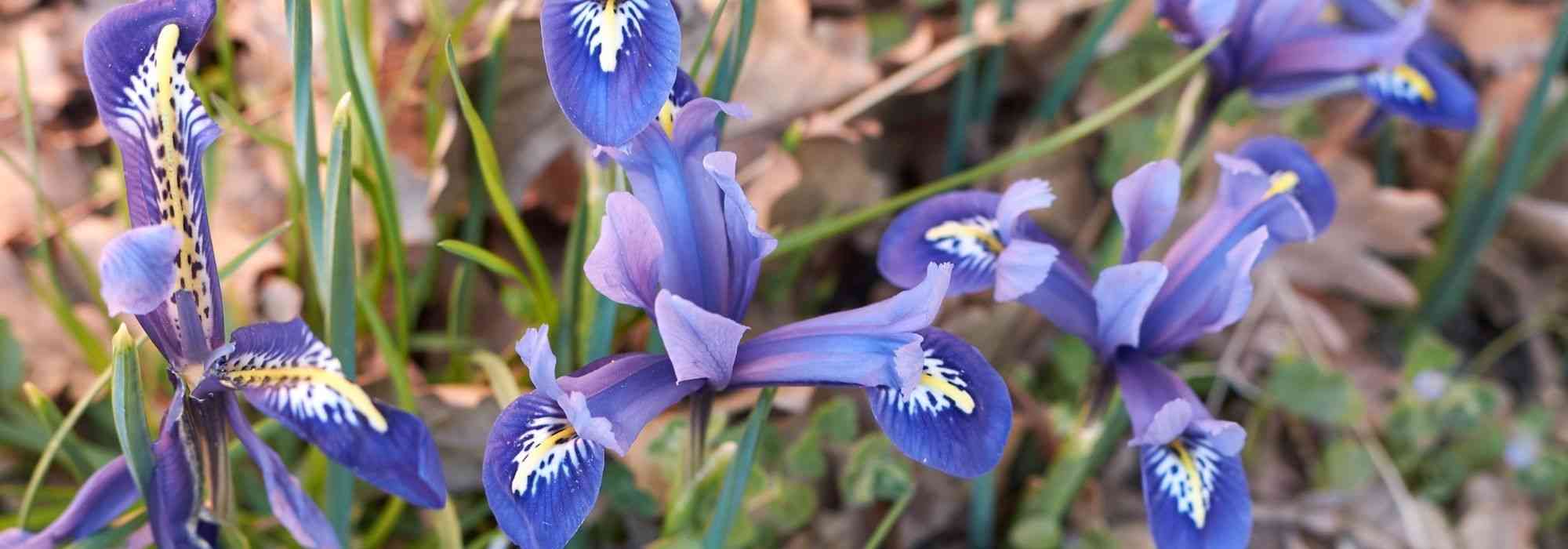
Iris reticulata: the most beautiful varieties
not to be missed!
Contents
With their beautiful colours of white, yellow, purple, or blue, Iris reticulata delight the end of winter with their flowering. Early bloomers, these dwarf bulbous plants brighten up borders, rockeries, and the bases of trees. Generally reaching a height of 15 cm, these dwarf Irises are perfect for flowering pots to cheer up a terrace or balcony with their lovely late winter blooms. Easy to grow and requiring almost no maintenance, the reticulate Iris can easily naturalise and spread independently. Here are our 7 favourite varieties to discover and easily combine in the garden or in pots.
To learn more, check out our complete guide: Iris reticulata: plant and grow
Iris reticulata 'Scent Sational'
At the end of winter, from February to March, Iris reticulata ‘Scent Sational’ reveals large flowers measuring 5 to 10 cm, tinted in a beautiful violet-blue. This colour is particularly intense. The three tepals that curl horizontally are marked with a white spot striated with indigo and a golden yellow line. Additionally, the flowers of this reticulate Iris are fragrant. During flowering, the fine, linear leaves gradually appear to form a tuft about twenty centimetres high, which will then elongate to 40 cm after flowering. This plant is very hardy (down to -15°C) due to its mountainous origins. This cultivar was awarded in 2009 in Canada. Thanks to its colour, the reticulate Iris ‘Scent Sational’ brings a lot of cheerfulness, whether in a border, in a pot, or in a rockery. For a beautiful harmony of colours, pair it with Daffodils, Muscari, Hyacinths, and Primroses.
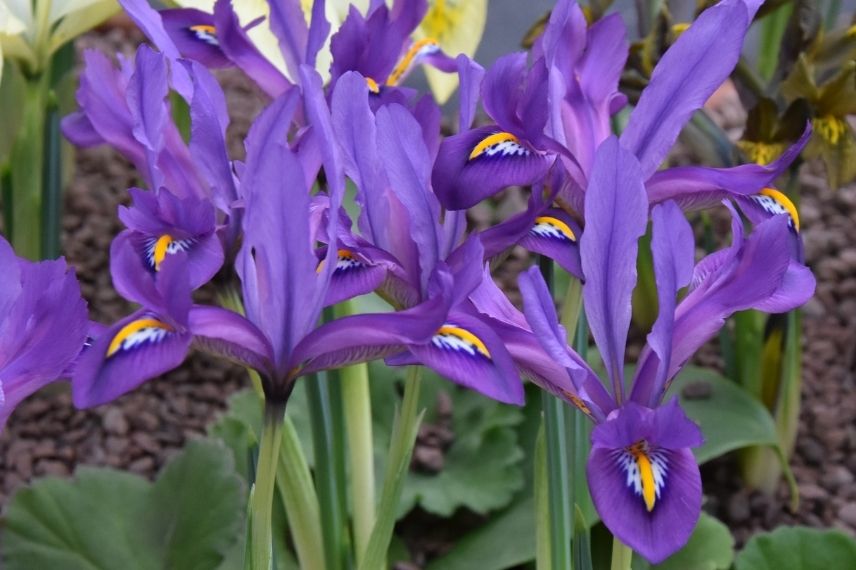
Iris reticulata ‘Scent Sational’
Read also
Iris reticulata : planting and growingIris reticulata 'White Caucasus'
The Iris reticulata ‘White Caucasus’ stands out with its pure white colour and a dazzling yellow crest at the centre of its tepals. These bright flowers, measuring around 8-10 cm, appear between February and March depending on the climate and are slightly fragrant. Like the Iris ‘Scent Sational’, the clump of foliage does not exceed 20 cm during flowering and will elongate once the flowers have faded. This dwarf Iris, recently developed in Canada, adds a truly elegant and refined touch to the garden. In a sunny white garden with well-drained soil, the reticulate Iris ‘White Caucasus’ is perfect for the edge of a flowerbed. It pairs beautifully with Snowdrops, Spring Crocuses, and Tulips. We can also mention the Iris reticulata ‘Natascha’, which also produces pure white flowers with soft petals highlighted in yellow.
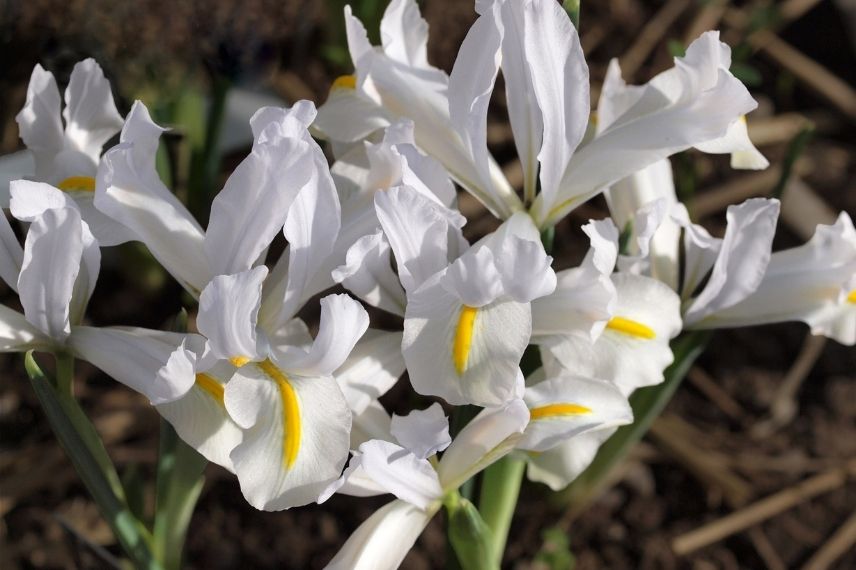
Iris reticulata ‘White Caucasus’
Discover other Iris Reticulata
View all →Available in 1 sizes
Available in 1 sizes
Available in 1 sizes
Available in 0 sizes
Available in 1 sizes
Available in 1 sizes
Available in 1 sizes
Available in 1 sizes
Available in 1 sizes
Available in 1 sizes
Iris reticulata 'Sunshine'
The Iris reticulata ‘Sunshine’ is a stunning and bright variety of reticulate iris. Before spring returns, it showcases flowers made up of 6 tepals, coloured in two shades of yellow, slightly spotted and lightly scented. Pale yellow and a deeper yellow, they are a delight to the eyes as winter fades and bring renewed energy. The name of this Canadian variety, ‘Sunshine’, suits it perfectly. As with all reticulate irises, the leaves gradually emerge during flowering. Initially, the foliage reaches only 15 to 20 cm, then it stretches to 30-40 cm as the flowers begin to wilt. This dwarf iris ‘Sunshine’ thrives in sunny positions where it catches the eye. Use it in a rockery, cool in winter and dry in summer, alongside hardy geraniums, grasses, garden irises (Iris germanica), Gauras, lavenders, or even herb plants like rosemary.

Iris reticulata ‘Sunshine’
Iris reticulata 'Katharina Hodgkin'
The Iris reticulata ‘Katharina Hodgkin’ is a variety of great softness and delicacy. Its sky-blue hue is exceptional. The petals are regularly striated with a more pronounced blue. A yellow mark provides contrast at the centre of the petals. Finally, a few small dark blue spots punctuate the yellow. Awarded the Award of Garden Merit by the Royal Horticultural Society (RHS), this cultivar reveals its lovely fragrant flowers, approximately 8 cm in size, typically in February-March. Its spreading tuft, measuring 15 cm in height, is adorned with glaucous green foliage. Then, in summer, this foliage yellows and disappears during the plant’s dormant period. In a sunny border, plant the Iris reticulata ‘Katharina Hodgkin’ with other miniature Irises to create a colourful display: Iris reticulata ‘Harmony’, Iris reticulata ‘Dijt’, and Iris reticulata ‘Natascha’.

Iris reticulata ‘Katharina Hodgkin’
Iris reticulata 'Spot On'
In the same style as the Iris ‘Scent Sational’, the Iris reticulata ‘Spot On’ is adorned with flowers of a rich hue. Its early and surprising flowering delights us with a well-thought-out display of colours. The flowers, measuring approximately 4-6 cm, are predominantly purple violet. The horizontal sepals each feature a white spot speckled and striated with indigo, becoming very dark (almost black) at the tip. A true little masterpiece! Smaller (10 cm in flower) than other reticulated Irises, this old cultivar, around twenty years old, is nonetheless full of charm. Developed in Canada, it is the result of the cross-breeding between Iris reticulata ‘Gem Purple’ and Iris reticulata var. Bakeriana from Turkey. The dwarf Iris ‘Spot On’ blooms from February to March, after which the glaucous deciduous foliage appears until summer when it disappears. On your terrace or balcony, create a scene of ephemeral flowering pots by pairing the dwarf Iris ‘Spot On’ with Iris pumila such as ‘Blue Denim’ and ‘Cherry Garden’, the Algerian Iris, or Anemones blanda such as ‘Blue Shades’ and ‘Charmer’.
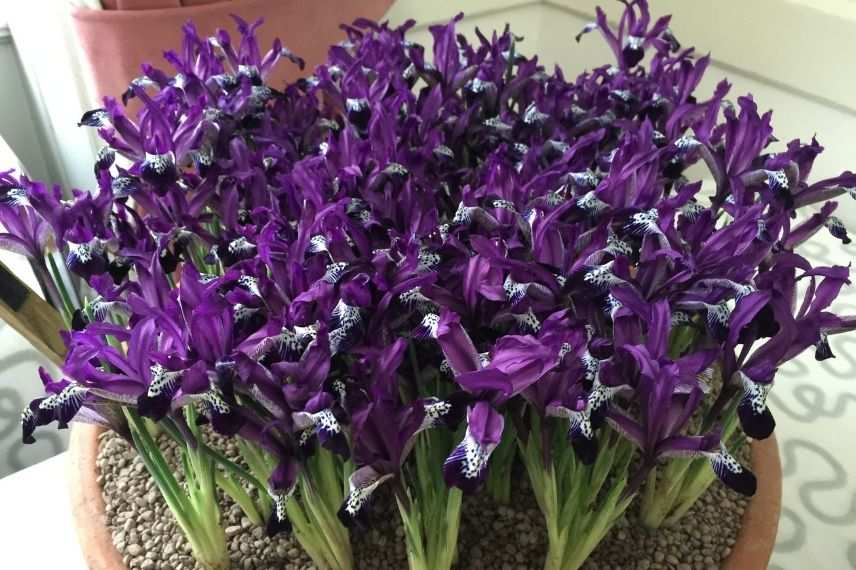
Iris reticulata ‘Spot On’
Iris reticulata 'Blue Note'
The Iris reticulata ‘Blue Note’ offers a display of colours of rare elegance. The petals that make up the flowers are very thin. Tinted with dark violet and ultramarine blue, the three largest sepals darken to midnight blue at the edges. Some white splashes as well as a touch of yellow appear at the centre of these sepals. This graphic flowering lasts from February to March. While the flowers are quite large (8 cm in diameter), they are unfortunately not fragrant. The Iris reticulata ‘Blue Note’ adapts well both in a garden and in a pot on a sunny terrace. It pairs nicely with Ipheions and Chionodoxas.
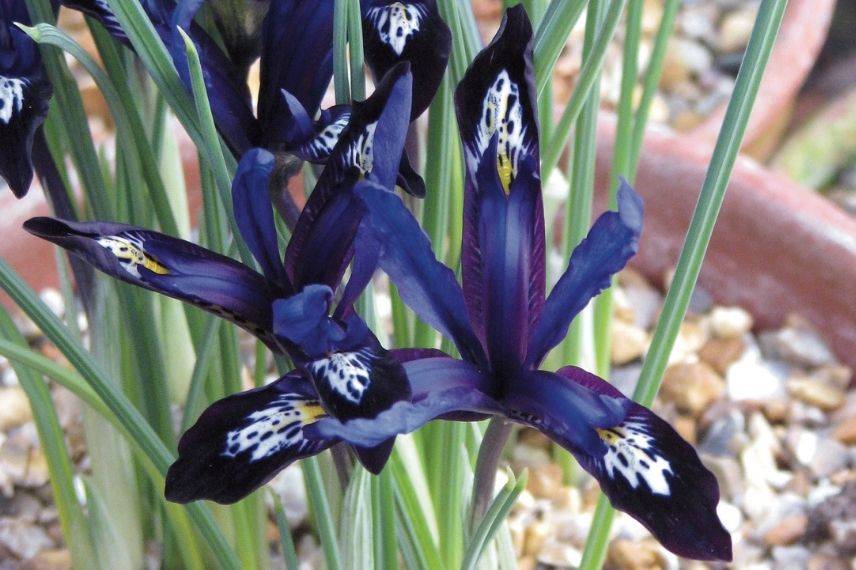
Iris reticulata ‘Blue Note’ (photo Peganum)
Iris reticulata 'Sea Breeze'
For a touch of holiday by the sea, let’s focus on the Iris reticulata ‘Sea Breeze’. This original reticulate iris has an uncommon style. It reminds us of the blue and white foam of the sea, as well as the fine, golden sand of the beach. From the end of winter to the beginning of spring, it dresses in blue and white like a watercolour painting in diluted shades, displaying dark veins. Speckled with blue-black, three broad, rounded sepals are tinged with yellow at their centre. Note that its solitary flowers, about 6-7 cm, are slightly fragrant. Plant this reticulate iris in groups from autumn at the base of trees or bushes alongside Eranthis or Allium triquetum, which bloom early in the year, from March to May.

Iris reticulata ‘Sea Breeze’
For further reading
- Discover all our tips for planting Iris reticulata in the ground
- Find all our tips for growing Iris reticulata in pots
- Subscribe!
- Contents
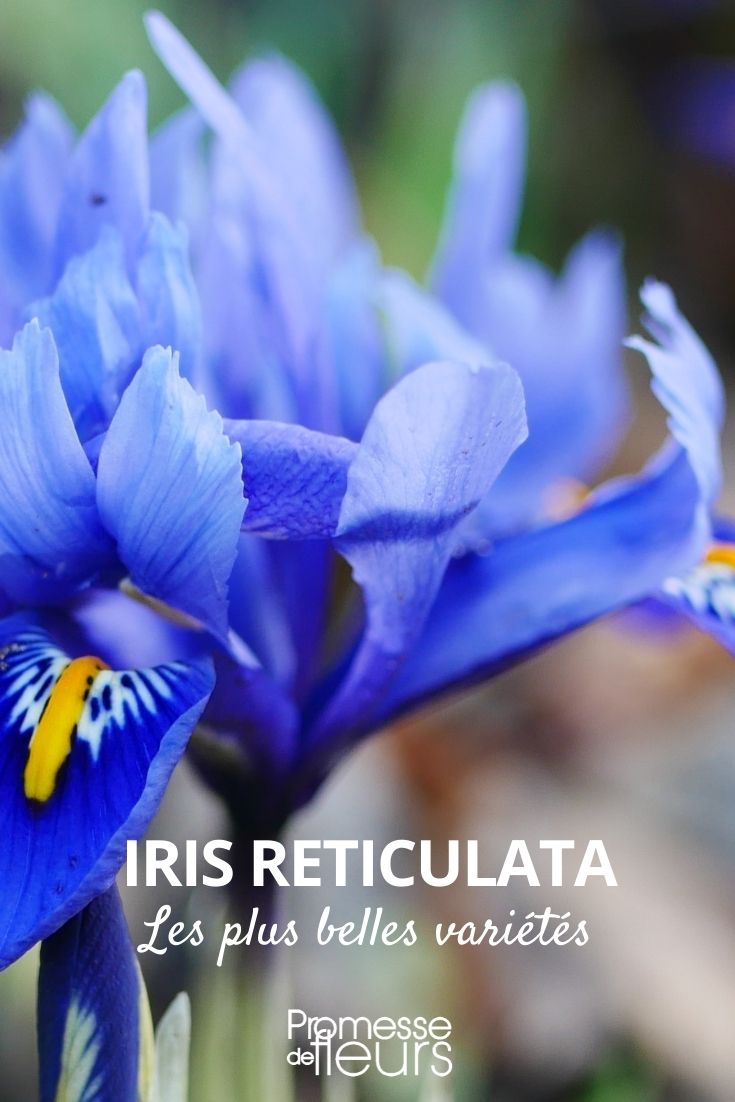































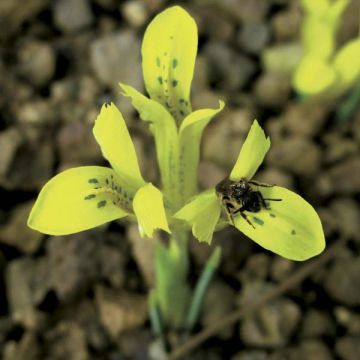

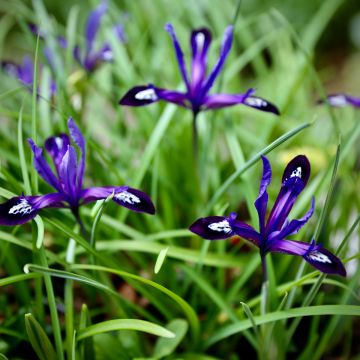

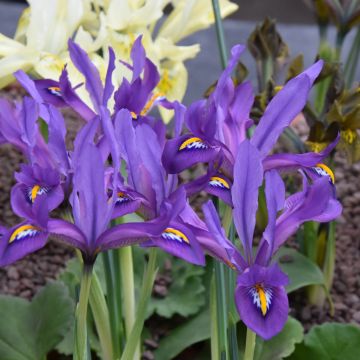


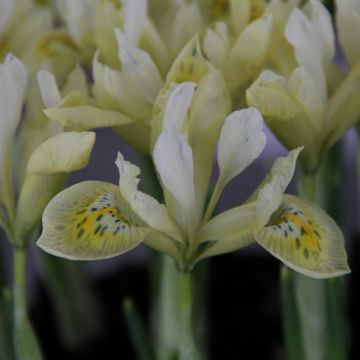

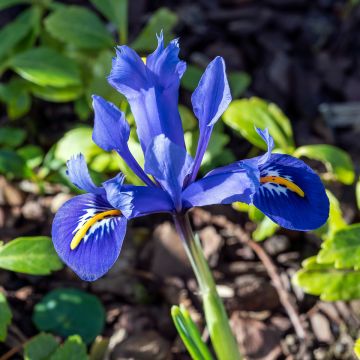
Comments